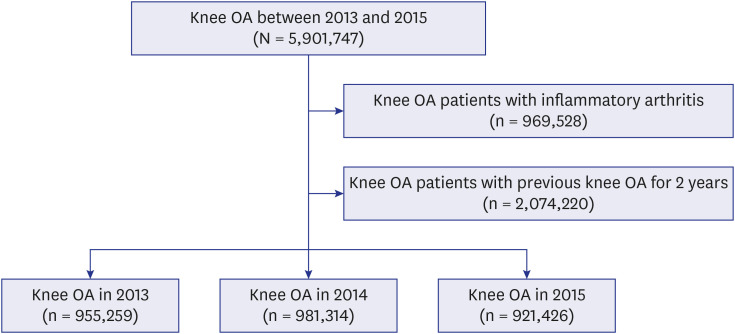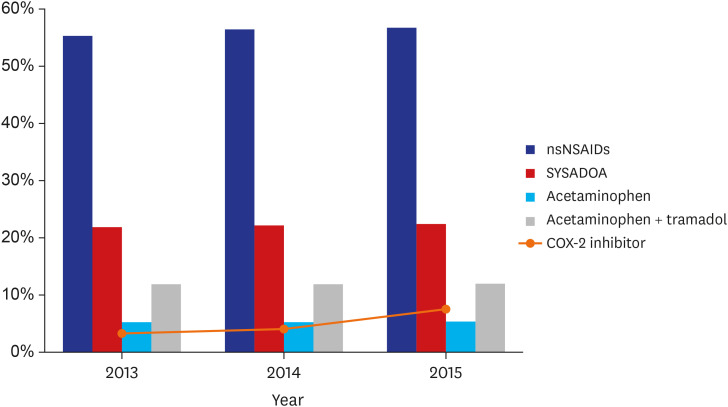J Korean Med Sci.
2022 May;37(18):e148. 10.3346/jkms.2022.37.e148.
COX-2 Inhibitor Use as an Early Treatment Option for Knee Osteoarthritis Patients in Korea: A Population-Based Cross-Sectional Study
- Affiliations
-
- 1Department of Rheumatology, Hanyang University Hospital for Rheumatic Diseases, Seoul, Korea
- 2Hanyang University Institute for Rheumatology Research, Seoul, Korea
- 3Department of Statistics, Kyungpook National University, Daegu, Korea
- 4College of Pharmacy, Chung-Ang University, Seoul, Korea
- 5Department of Information Statistics, Andong National University, Andong, Korea
- KMID: 2529714
- DOI: http://doi.org/10.3346/jkms.2022.37.e148
Abstract
- Background
To investigate the use of cyclooxygenase-2 (COX-2) inhibitors as an initial drug treatment for knee osteoarthritis (OA) patients.
Methods
From 2013 to 2015, patients with knee OA were identified from the Korean nationwide claims database. Among them, we extracted incident cases of knee OA to identify the initial drug treatment. Trends in the use of non-steroid anti-inflammatory drugs (NSAIDs) including COX-2 inhibitors were analyzed during the first year after their diagnosis. Associated factors for COX-2 inhibitor use were examined using a multivariate logistic regression model.
Results
We identified 2,857,999 incident knee OA patients (955,259 in 2013, 981,314 in 2014, and 921,426 in 2015). The mean ± standard deviation age of patients was 64.2 ± 9.8 years. The frequency of COX-2 inhibitor use as initial treatment increased from 3.5% in 2013 to 7.2% in 2015 (P < 0.01). In patients taking the medication regularly for one year after diagnosis (medication possession ratio ≥ 50%), COX-2 inhibitor use also rapidly increased from 5.5% in 2013 to 11.1% in 2015 (P < 0.01). However, the frequencies of non-selective NSAID and analgesic use did not decrease remarkably. Factors associated with patients using COX-2 inhibitors on initial drug treatment were older age (odds ratio [OR], 1.08), female (OR, 1.24), and comorbidity (OR, 1.03). Type of institution, physician speciality, and insurance type of patients were also associated.
Conclusion
In Korea, COX-2 inhibitors have rapidly increased as an initial treatment for knee OA patients, but it has not appeared to reduce the use of non-selective NSAIDs and analgesics.
Keyword
Figure
Reference
-
1. Sharma L. Osteoarthritis of the Knee. N Engl J Med. 2021; 384(1):51–59. PMID: 33406330.2. Kim YE, Jo MW, Park H, Oh IH, Yoon SJ, Pyo J, et al. Updating disability weights for measurement of healthy life expectancy and disability-adjusted life year in Korea. J Korean Med Sci. 2020; 35(27):e219. PMID: 32657086.3. Kolasinski SL, Neogi T, Hochberg MC, Oatis C, Guyatt G, Block J, et al. 2019 American College of Rheumatology/Arthritis Foundation Guideline for the management of osteoarthritis of the hand, hip, and knee. Arthritis Rheumatol. 2020; 72(2):220–233. PMID: 31908163.4. Bannuru RR, Osani MC, Vaysbrot EE, Arden NK, Bennell K, Bierma-Zeinstra SM, et al. OARSI guidelines for the non-surgical management of knee, hip, and polyarticular osteoarthritis. Osteoarthritis Cartilage. 2019; 27(11):1578–1589. PMID: 31278997.5. Pendleton A, Arden N, Dougados M, Doherty M, Bannwarth B, Bijlsma JW, et al. EULAR recommendations for the management of knee osteoarthritis: report of a task force of the Standing Committee for International Clinical Studies Including Therapeutic Trials (ESCISIT). Ann Rheum Dis. 2000; 59(12):936–944. PMID: 11087696.6. American Geriatrics Society Panel on the Pharmacological Management of Persistent Pain in Older Persons. Pharmacological management of persistent pain in older persons. Pain Med. 2009; 10(6):1062–1083. PMID: 19744205.7. Bruyère O, Cooper C, Pelletier JP, Maheu E, Rannou F, Branco J, et al. A consensus statement on the European Society for Clinical and Economic Aspects of Osteoporosis and Osteoarthritis (ESCEO) algorithm for the management of knee osteoarthritis—from evidence-based medicine to the real-life setting. Semin Arthritis Rheum. 2016; 45(4 Suppl):S3–11. PMID: 26806188.8. McAlindon TE, Bannuru RR, Sullivan MC, Arden NK, Berenbaum F, Bierma-Zeinstra SM, et al. OARSI guidelines for the non-surgical management of knee osteoarthritis. Osteoarthritis Cartilage. 2014; 22(3):363–388. PMID: 24462672.9. Gore M, Tai KS, Sadosky A, Leslie D, Stacey BR. Use and costs of prescription medications and alternative treatments in patients with osteoarthritis and chronic low back pain in community-based settings. Pain Pract. 2012; 12(7):550–560. PMID: 22304678.10. Kingsbury SR, Gross HJ, Isherwood G, Conaghan PG. Osteoarthritis in Europe: impact on health status, work productivity and use of pharmacotherapies in five European countries. Rheumatology (Oxford). 2014; 53(5):937–947. PMID: 24489012.11. Park HR, Cho SK, Im SG, Jung SY, Kim D, Jang EJ, et al. Treatment patterns of knee osteoarthritis patients in Korea. Korean J Intern Med. 2019; 34(5):1145–1153. PMID: 29551051.12. Cho SK, Jung SY, Choi S, Im SG, Kim H, Choi WS, et al. Factors related to the use of opioids as early treatment in patients with knee osteoarthritis. Arthritis Res Ther. 2019; 21(1):222. PMID: 31685008.13. Sabha M, Hochberg MC. Non-surgical management of hip and knee osteoarthritis; comparison of ACR/AF and OARSI 2019 and VA/DoD 2020 guidelines. Osteoarthritis and Cartilage Open. 2022; 4(1):100232.14. Stewart M, Cibere J, Sayre EC, Kopec JA. Efficacy of commonly prescribed analgesics in the management of osteoarthritis: a systematic review and meta-analysis. Rheumatol Int. 2018; 38(11):1985–1997. PMID: 30120508.15. Puljak L, Marin A, Vrdoljak D, Markotic F, Utrobicic A, Tugwell P. Celecoxib for osteoarthritis. Cochrane Database Syst Rev. 2017; 5(5):CD009865. PMID: 28530031.16. Park JS, Lee CH. Clinical study using healthcare claims database. J Rheum Dis. 2021; 28(3):119–125.17. Park HR, Im S, Kim H, Jung SY, Kim D, Jang EJ, et al. Validation of algorithms to identify knee osteoarthritis patients in the claims database. Int J Rheum Dis. 2019; 22(5):890–896. PMID: 30729731.18. Elixhauser A, Steiner C, Harris DR, Coffey RM. Comorbidity measures for use with administrative data. Med Care. 1998; 36(1):8–27. PMID: 9431328.19. Kozma CM, Dickson M, Phillips AL, Meletiche DM. Medication possession ratio: implications of using fixed and variable observation periods in assessing adherence with disease-modifying drugs in patients with multiple sclerosis. Patient Prefer Adherence. 2013; 7:509–516. PMID: 23807840.20. Dalal D, Dubreuil M, Peloquin C, Neogi T, Zhang Y, Choi H, et al. Meloxicam and risk of myocardial infarction: a population-based nested case-control study. Rheumatol Int. 2017; 37(12):2071–2078. PMID: 29030657.21. Cryer B, Feldman M. Cyclooxygenase-1 and cyclooxygenase-2 selectivity of widely used nonsteroidal anti-inflammatory drugs. Am J Med. 1998; 104(5):413–421. PMID: 9626023.22. Curtis E, Fuggle N, Shaw S, Spooner L, Ntani G, Parsons C, et al. Safety of cyclooxygenase-2 inhibitors in osteoarthritis: outcomes of a systematic review and meta-analysis. Drugs Aging. 2019; 36(Suppl 1):25–44. PMID: 31073922.23. Tang YZ, Zeng P, Liao Y, Qin Z, Zhang H, Li B, et al. Correlation between perioperative parecoxib use and postoperative acute kidney injury in patients undergoing non-cardiac surgery: a retrospective cohort analysis. BMJ Open. 2021; 11(8):e047840.24. Hochberg MC. Mortality in osteoarthritis. Clin Exp Rheumatol. 2008; 26(5):Suppl 51. S120–S124. PMID: 19026154.25. Nüesch E, Dieppe P, Reichenbach S, Williams S, Iff S, Jüni P. All cause and disease specific mortality in patients with knee or hip osteoarthritis: population based cohort study. BMJ. 2011; 342:d1165. PMID: 21385807.26. Cooper C, Chapurlat R, Al-Daghri N, Herrero-Beaumont G, Bruyère O, Rannou F, et al. Safety of oral non-selective non-steroidal anti-inflammatory drugs in osteoarthritis: what does the literature say? Drugs Aging. 2019; 36(1):Suppl 1. 15–24. PMID: 31073921.27. Park KK, Choi CH, Ha CW, Lee MC. The effects of adherence to non-steroidal anti-inflammatory drugs and factors influencing drug adherence in patients with knee osteoarthritis. J Korean Med Sci. 2016; 31(5):795–800. PMID: 27134504.28. Wu R, Ma Y, Yang Y, Li M, Zheng Q, Fu G. A clinical model for predicting knee replacement in early-stage knee osteoarthritis: data from osteoarthritis initiative. Clin Rheumatol. 2022; 41(4):1199–1210. PMID: 34802087.
- Full Text Links
- Actions
-
Cited
- CITED
-
- Close
- Share
- Similar articles
-
- India-Based Knee Osteoarthritis Evaluation (iKare): A Multi-Centre Cross-Sectional Study on the Management of Knee Pain and Early Osteoarthritis in India
- The Relationship between Osteoarthritis of the Knee and Bone Mineral Density of Proximal Femur: A Cross-Sectional Study from a Korean Population in Women
- The Association of Obesity with Knee Osteoarthritis in a Rural Population
- Guidelines for the Treatment of Osteoarthritis of the Knee
- Relationships among Obesity, Sarcopenia, and Osteoarthritis in the Elderly



